Initial Growth of Gmelina arborea and Efficacy of RGB Image to Capture Canopy Area in a Large Range of Stockings
Abstract
:1. Introduction
2. Materials and Methods
2.1. Study Site
2.2. Nelder Experiment Plantation of Gmelina Arborea
2.3. Tree Measurements in the Field
2.4. Red-Green-Blue (RGB) Image Capture
2.5. Statistical Analysis
3. Results
4. Discussion
5. Conclusions
Author Contributions
Funding
Data Availability Statement
Acknowledgments
Conflicts of Interest
References
- Lewis, S.L.; Wheeler, C.E.; Mitchard, E.T.; Koch, A. Restoring natural forests is the best way to remove atmospheric carbon. Nature 2019, 568, 25–28. [Google Scholar] [CrossRef] [PubMed]
- Food and Agriculture Organization. Global Forest Resources Assessment 2020. In Key Findings; Food and Agriculture Organization: Rome, Italy, 2020. [Google Scholar] [CrossRef]
- Cubbage, F.; Kanieski, B.; Rubilar, R.; Bussoni, A.; Olmos, V.M.; Balmelli, G.; Donagh, P.M.; Lord, R.; Hernández, C.; Zhang, P.; et al. Global timber investments, 2005 to 2017. For. Policy Econ. 2020, 112, 102082. [Google Scholar] [CrossRef]
- CONAFOR. Protocolo Para la Definición de Áreas Elegibles 2022 del Componente II. Plantaciones Forestales Comerciales y Sistemas Agroforestales Para el Bienestar (PFC); CONAFOR: Zapopan, Mexico, 2022. [Google Scholar]
- Nyland, R.D. Silviculture: Concepts and Applications; Waveland Press: Long Grove, IL, USA, 2016; p. 633. [Google Scholar]
- Schönau, A.P.G.; Coetzee, J. Initial spacing, stand density and thinning in eucalypt plantations. For. Ecol. Manag. 1989, 29, 245–266. [Google Scholar] [CrossRef]
- Hakamada, R.E.; Binkley, D.; Cegatta, I.; Alvares, C.; Campoe, O.C.; Stape, J.L. Stocking response of Eucalyptus growth depends on site water deficit across a 2100-km gradient in Brazil. For. Ecol. Manag. 2023, 546, 121325. [Google Scholar] [CrossRef]
- Pugnaire, F.; Valladares, F. Handbook of Functional Plant Ecology; CRC Press: Boca Raton, FL, USA, 1999; p. 928. [Google Scholar]
- Echereme Chidi, B.; Mbaekwe Ebenezer, I.; Ekwealor Kenneth, U. Tree crown architecture: Approach to tree form, structure and performance: A review. Int. J. Sci. Res. Publ. 2015, 5, 1–5. [Google Scholar]
- Hakamada, R.; da Silva, R.M.L.; Moreira, G.G.; Teixeira, J.D.S.; Takahashi, S.; Masson, M.V.; Ferreira, K.Z.; Fernandes, P.G.; Martins, S.D.S. Growth and canopy traits affected by myrtle rust (Austropuccinia psidii Winter) in Eucalyptus grandis x Eucalyptus urophylla. For. Pathol. 2022, 52, e12736. [Google Scholar] [CrossRef]
- Pook, E. Canopy dynamics of Eucalyptus maculata Hook. III Effects of drought. Aust. J. Bot. 1985, 33, 65–79. [Google Scholar] [CrossRef]
- Hernandez-Santin, L.; Rudge, M.L.; Bartolo, R.E.; Erskine, P.D. Identifying species and monitoring understorey from UAS-derived data: A literature review and future directions. Drones 2019, 3, 9. [Google Scholar] [CrossRef]
- Müllerová, J.; Brůna, J.; Dvořák, P.; Bartaloš, T.; Vítková, M. Does the data resolution/origin matter? Satellite, airborne and UAV imagery to tackle plant invasions. Int. Arch. Photogramm. Remote Sens. Spat. Inf. Sci. 2016, 41, 903–908. [Google Scholar] [CrossRef]
- Jafarbiglu, H.; Pourreza, A. A comprehensive review of remote sensing platforms, sensors, and applications in nut crops. Comput. Electron. Agric. 2022, 197, 106844. [Google Scholar] [CrossRef]
- Grybas, H.; Congalton, R.G. A comparison of multi-temporal RGB and multispectral UAS imagery for tree species classification in heterogeneous New Hampshire Forests. Remote Sens. 2021, 13, 2631. [Google Scholar] [CrossRef]
- Ashapure, A.; Jung, J.; Chang, A.; Oh, S.; Maeda, M.; Landivar, J. A Comparative Study of RGB and Multispectral Sensor-Based Cotton Canopy Cover Modelling Using Multi-Temporal UAS Data. Remote Sens. 2019, 11, 2757. [Google Scholar] [CrossRef]
- Osco, L.P.; Arruda, M.d.S.d.; Marcato Junior, J.; da Silva, N.B.; Ramos, A.P.M.; Moryia, É.A.S.; Imai, N.N.; Pereira, D.R.; Creste, J.E.; Matsubara, E.T.; et al. A convolutional neural network approach for counting and geolocating citrus-trees in UAV multispectral imagery. ISPRS J. Photogramm. Remote Sens. 2020, 160, 97–106. [Google Scholar] [CrossRef]
- Xie, Y.; Sha, Z.; Yu, M. Remote sensing imagery in vegetation mapping: A review. J. Plant Ecol. 2008, 1, 9–23. [Google Scholar] [CrossRef]
- Zhou, Y.; Lao, C.; Yang, Y.; Zhang, Z.; Chen, H.; Chen, Y.; Chen, J.; Ning, J.; Yang, N. Diagnosis of winter-wheat water stress based on UAV-borne multispectral image texture and vegetation indices. Agric. Water Manag. 2021, 256, 107076. [Google Scholar] [CrossRef]
- Dell, M.; Stone, C.; Osborn, J.; Glen, M.; McCoull, C.; Rimbawanto, A.; Tjahyono, B.; Mohammed, C. Detection of necrotic foliage in a young Eucalyptus pellita plantation using unmanned aerial vehicle RGB photography—A demonstration of concept. Aust. For. 2019, 82, 79–88. [Google Scholar] [CrossRef]
- Liao, L.; Cao, L.; Xie, Y.; Luo, J.; Wang, G. Phenotypic traits extraction and genetic characteristics assessment of eucalyptus trials based on UAV-borne LiDAR and RGB images. Remote Sens. 2022, 14, 765. [Google Scholar] [CrossRef]
- Zhao, H.; Wang, Y.; Sun, Z.; Xu, Q.; Liang, D. Failure Detection in Eucalyptus Plantation Based on UAV Images. Forests 2021, 12, 1250. [Google Scholar] [CrossRef]
- Almeida, A.; Gonçalves, F.; Silva, G.; Mendonça, A.; Gonzaga, M.; Silva, J.; Souza, R.; Leite, I.; Neves, K.; Boeno, M.; et al. Individual Tree Detection and Qualitative Inventory of a Eucalyptus sp. Stand Using UAV Photogrammetry Data. Remote Sens. 2021, 13, 3655. [Google Scholar] [CrossRef]
- Wolff, F.; Kolari, T.H.M.; Villoslada, M.; Tahvanainen, T.; Korpelainen, P.; Zamboni, P.A.P.; Kumpula, T. RGB vs. Multispectral imagery: Mapping aapa mire plant communities with UAVs. Ecol. Indic. 2023, 148, 110140. [Google Scholar] [CrossRef]
- Westoby, M.J.; Brasington, J.; Glasser, N.F.; Hambrey, M.J.; Reynolds, J.M. ‘Structure-from-Motion’ photogrammetry: A low-cost, effective tool for geoscience applications. Geomorphology 2012, 179, 300–314. [Google Scholar] [CrossRef]
- Pourreza, M.; Moradi, F.; Khosravi, M.; Deljouei, A.; Vanderhoof, M.K. GCPs-free photogrammetry for estimating tree height and crown diameter in Arizona Cypress plantation using UAV-mounted GNSS RTK. Forests 2022, 13, 1905. [Google Scholar] [CrossRef]
- Karl, J.W.; Yelich, J.V.; Ellison, M.J.; Lauritzen, D. Estimates of willow (Salix spp.) canopy volume using unmanned aerial systems. Rangel. Ecol. Manag. 2020, 73, 531–537. [Google Scholar] [CrossRef]
- Iizuka, K.; Yonehara, T.; Itoh, M.; Kosugi, Y. Estimating tree height and diameter at breast height (DBH) from digital surface models and orthophotos obtained with an unmanned aerial system for a Japanese cypress (Chamaecyparis obtusa) forest. Remote Sens. 2017, 10, 13. [Google Scholar] [CrossRef]
- Shin, P.; Sankey, T.; Moore, M.M.; Thode, A.E. Evaluating Unmanned Aerial Vehicle Images for Estimating Forest Canopy Fuels in a Ponderosa Pine Stand. Remote Sens. 2018, 10, 1266. [Google Scholar] [CrossRef]
- Sánchez Rejón, L.A.; Luis Romero, J. Plantations of Gmelina arborea in southern Mexico. New For. 2004, 28, 293–297. [Google Scholar] [CrossRef]
- INEGI. Istituro Nacional de Estadistica y Geografía. Available online: https://www.inegi.org.mx/temas/climatologia/ (accessed on 1 August 2023).
- Walkley, A.; Black, I.A. An examination of the Degtjareff method for determining soil organic matter, and a proposed modification of the chromic acid titration method. Soil Sci. 1934, 37, 29–38. [Google Scholar] [CrossRef]
- Stape, J.L.; Binkley, D. Insights from full-rotation Nelder spacing trials with Eucalyptus in Sao Paulo, Brazil. South. For. 2010, 72, 91–98. [Google Scholar] [CrossRef]
- Ruano, I.; Herrero de Aza, C.; Bravo, F. Effect of density on Mediterranean pine seedlings using the Nelder wheel design: Analysis of biomass production. Forestry 2022, 95, 711–726. [Google Scholar] [CrossRef]
- Avery, T.E.; Burkhart, H.E. Forest Measurements; Waveland Press: Long Grove, IL, USA, 2015. [Google Scholar]
- Melo Cruz, O.A. Modelación del Crecimiento, Acumulación de Biomasa y Captura de Carbono en Árboles de Gmelina Arborea Roxb., Asociados a Sistemas Agroforestales y Plantaciones Homogéneas en Colombia, 3rd ed.; Universidad Nacional de Colombia: Medellín, Colombia, 2015; pp. 154–196. [Google Scholar]
- Berenguer, E.; Ferreira, J.; Gardner, T.A.; Aragão, L.E.O.C.; De Camargo, P.B.; Cerri, C.E.; Durigan, M.; Oliveira, R.C.D.; Vieira, I.C.G.; Barlow, J. A large-scale field assessment of carbon stocks in human-modified tropical forests. Glob. Chang. Biol. 2014, 20, 3713–3726. [Google Scholar] [CrossRef]
- Sayn-Wittgenstein, L.; Aldred, A.H. Tree size from large-scale photos. Photogramm. Eng. 1972, 38, 971–973. [Google Scholar]
- Congedo, L. Semi-automatic classification plugin documentation. Release 2016, 4, 29. [Google Scholar]
- Ruwaimana, M.; Satyanarayana, B.; Otero, V.; Muslim, A.M.; Syafiq, A.M.; Ibrahim, S.; Raymaekers, D.; Koedam, N.; Dahdouh-Guehbas, F. The advantages of using drones over space-borne imagery in the mapping of mangrove forests. PLoS ONE 2018, 13, e0200288. [Google Scholar] [CrossRef]
- Kruse, F.A.; Lefkoff, A.B.; Boardman, J.W.; Heidebrecht, K.B.; Shapiro, A.T.; Barloon, P.J.; Goetz, A.F.H. The spectral image processing system (SIPS)—Interactive visualization and analysis of imaging spectrometer data. Remote Sens. Environ. 1993, 44, 145–163. [Google Scholar] [CrossRef]
- Hyams, D.G. CurveExpert Professional Documentation, 3rd ed.; Release: St. Paul, MN, USA, 2008; pp. 154–196. [Google Scholar]
- Hakamada, R.E.; Binkley, D.; Cegatta, I.; Alvares, C.; Campoe, O.C.; Stape, J.L. Validation of an efficient visual method for estimating leaf area index in clonal Eucalyptus plantations. South. For. A J. For. Sci. 2016, 78, 275–281. [Google Scholar] [CrossRef]
- Peña, J.M.; Torres Sánchez, J.; Serrano Pérez, A.; De Castro, A.I.; López Granados, F. Quantifying efficacy and limits of unmanned aerial vehicle (UAV) technology for weed seedling detection as affected by sensor resolution. Sensors 2015, 15, 5609–5626. [Google Scholar] [CrossRef]
- Torres Sánchez, J.; López Granados, F.; De Castro, A.I.; Peña Barragán, J.M. Configuration and specifications of an unmanned aerial vehicle (UAV) for early site specific weed management. PLoS ONE 2013, 8, e58210. [Google Scholar] [CrossRef]
- Ford, J.; Sadgrove, E.; Paul, D. Developing an extreme learning machine based approach to weed segmentation in pastures. Smart Agric. Technol. 2023, 5, 100288. [Google Scholar] [CrossRef]
- Woebbecke, D.M.; Meyer, G.E.; Von Bargen, K.; Mortensen, D.A. Color indices for weed identification under various soil, residue, and lighting conditions. Trans. ASAE 1995, 38, 259–269. [Google Scholar] [CrossRef]
- López Granados, F.; Torres Sánchez, J.; Serrano Pérez, A.; de Castro, A.I.; Mesas Carrascosa, F.J.; Peña, J.M. Early season weed mapping in sunflower using UAV technology: Variability of herbicide treatment maps against weed thresholds. Precis. Agric. 2016, 17, 183–199. [Google Scholar] [CrossRef]
- Torres Sánchez, J.; Peña, J.M.; de Castro, A.I.; López Granados, F. Multi-temporal mapping of the vegetation fraction in early-season wheat fields using images from UAV. Comput. Electron. Agric. 2014, 103, 104–113. [Google Scholar] [CrossRef]
- Raymond Hunt, E.; Gillham, J.H.; Daughtry, C.S.T. Improving Potential Geographic Distribution Models for Invasive Plants by Remote Sensing. Rangel. Ecol. Manag. 2010, 63, 505–513. [Google Scholar] [CrossRef]
- Louargant, M.; Jones, G.; Faroux, R.; Paoli, J.N.; Maillot, T.; Gée, C.; Villette, S. Unsupervised Classification Algorithm for Early Weed Detection in Row-Crops by Combining Spatial and Spectral Information. Remote Sens. 2018, 10, 761. [Google Scholar] [CrossRef]
- Carter, G.A.; Knapp, A.K. Leaf optical properties in higher plants: Linking spectral characteristics to stress and chlorophyll concentration. Am. J. Bot. 2001, 88, 677–684. [Google Scholar] [CrossRef]
- Hakamada, R.E.; Hubbard, R.M.; Moreira, G.G.; Stape, J.L.; Campoe, O.; de Barros Ferraz, S.F. Influence of stand density on growth and water use efficiency in Eucalyptus clones. For. Ecol. Manag. 2020, 466, 118125. [Google Scholar] [CrossRef]
- Binkley, D.; Campoe, O.C.; Alvares, C.; Carneiro, R.L.; Cegatta, Í.; Stape, J.L. The interactions of climate, spacing and genetics on clonal Eucalyptus plantations across Brazil and Uruguay. For. Ecol. Manag. 2017, 405, 271–283. [Google Scholar] [CrossRef]
- Huang, C.-W.; Chu, C.-R.; Hsieh, C.-I.; Palmroth, S.; Katul, G.G. Wind-induced leaf transpiration. Adv. Water Resour. 2015, 86, 240–255. [Google Scholar] [CrossRef]
- Gardiner, B.; Byrne, K.; Hale, S.; Kamimura, K.; Mitchell, S.J.; Peltola, H.; Ruel, J.-C. A review of mechanistic modelling of wind damage risk to forests. Forestry 2008, 81, 447–463. [Google Scholar] [CrossRef]
- Unger, P.W.; Kaspar, T.C. Soil Compaction and Root Growth: A Review. Agron. J. 1994, 86, 759–766. [Google Scholar] [CrossRef]
- Drewry, J.; Cameron, K.; Buchan, G. Pasture yield and soil physical property responses to soil compaction from treading and grazing—A review. Soil Res. 2008, 46, 237–256. [Google Scholar] [CrossRef]
- Shao, H.; Xia, T.; Wu, D.; Chen, F.; Mi, G. Root growth and root system architecture of field-grown maize in response to high planting density. Plant Soil 2018, 430, 395–411. [Google Scholar] [CrossRef]
- Swamy, S.L.; Puri, S.; Singh, A.K. Growth, biomass, carbon storage and nutrient distribution in Gmelina arborea Roxb. stands on red lateritic soils in central India. Bioresour. Technol. 2003, 90, 109–126. [Google Scholar] [CrossRef] [PubMed]
- Rasineni, G.K.; Guha, A.; Reddy, A.R. Elevated CO2 atmosphere significantly increased photosynthesis and productivity in a fast growing tree species, Gmelina arborea Roxb. Clim. Chang. Environ. Sustain. 2013, 1, 81. [Google Scholar] [CrossRef]
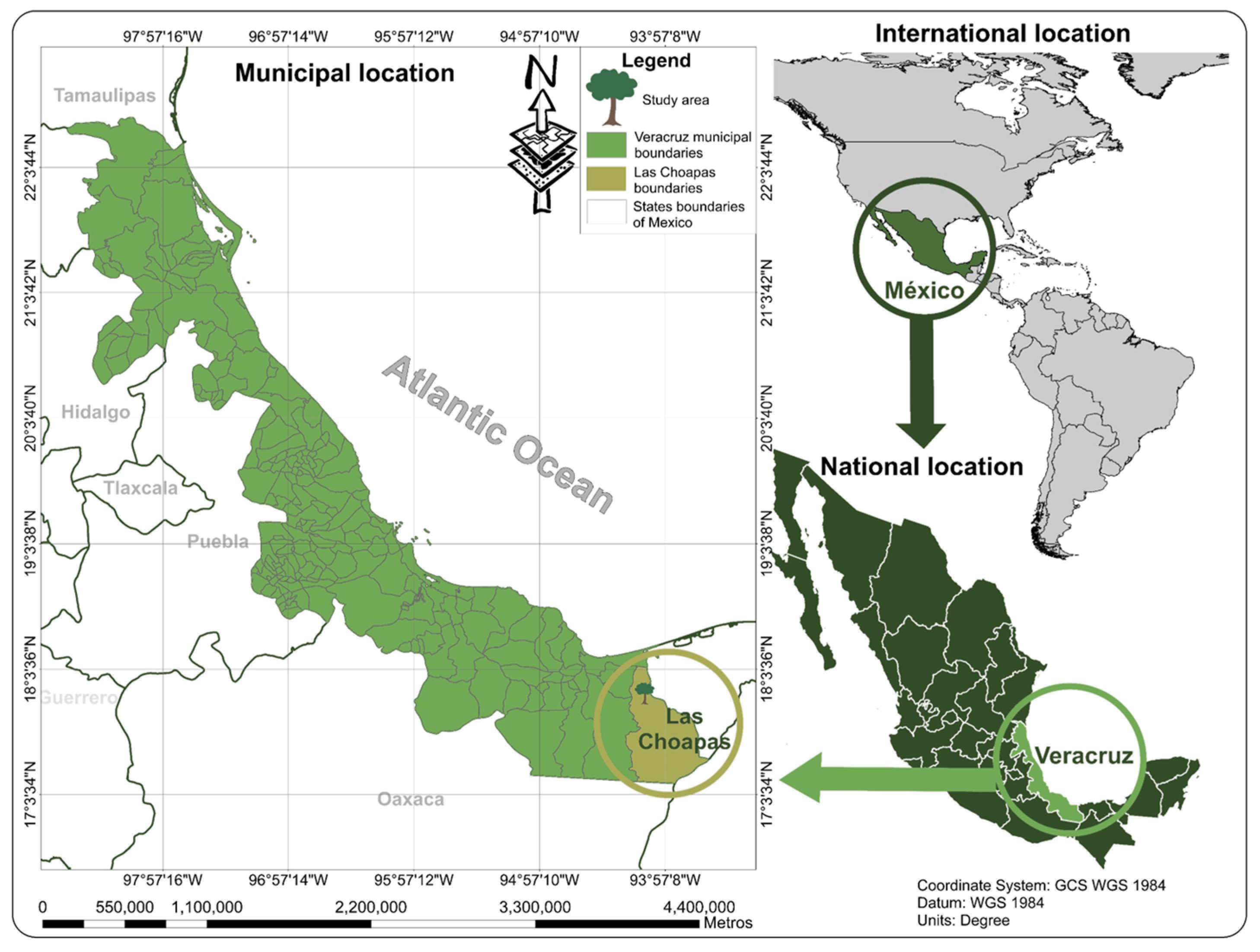
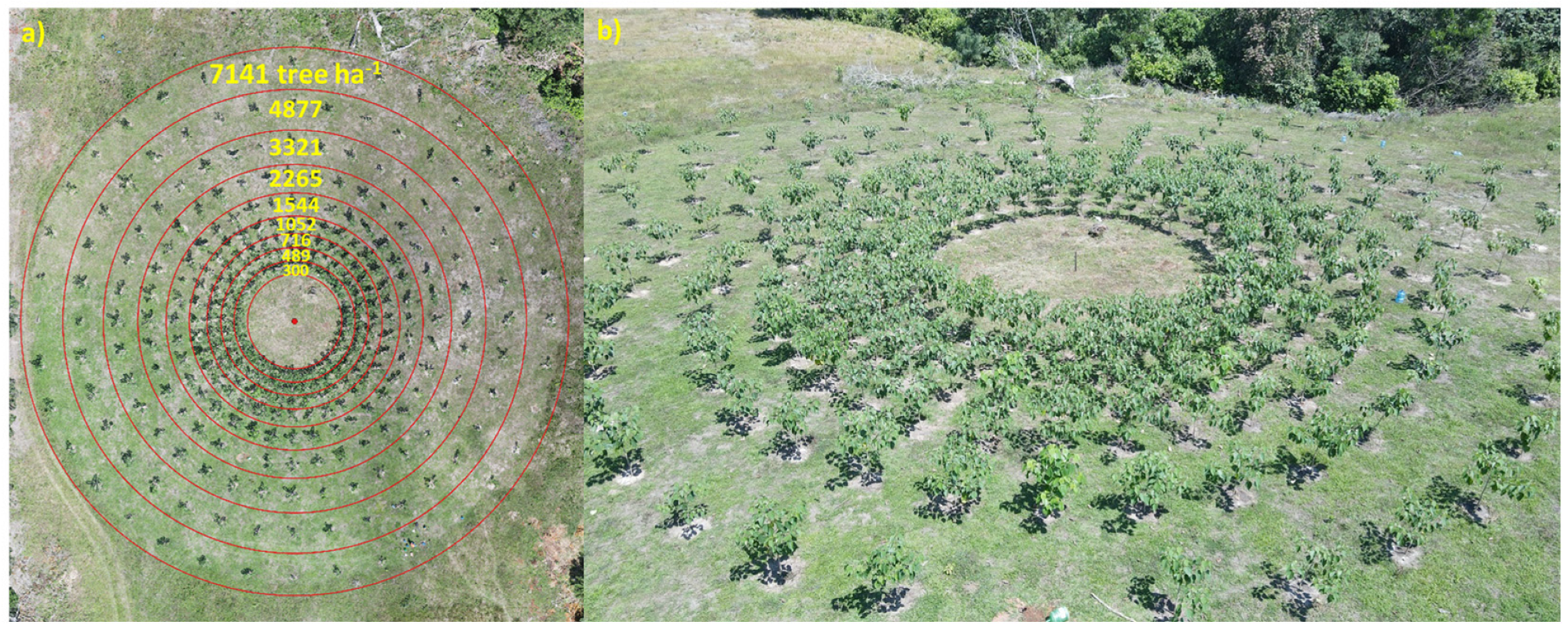
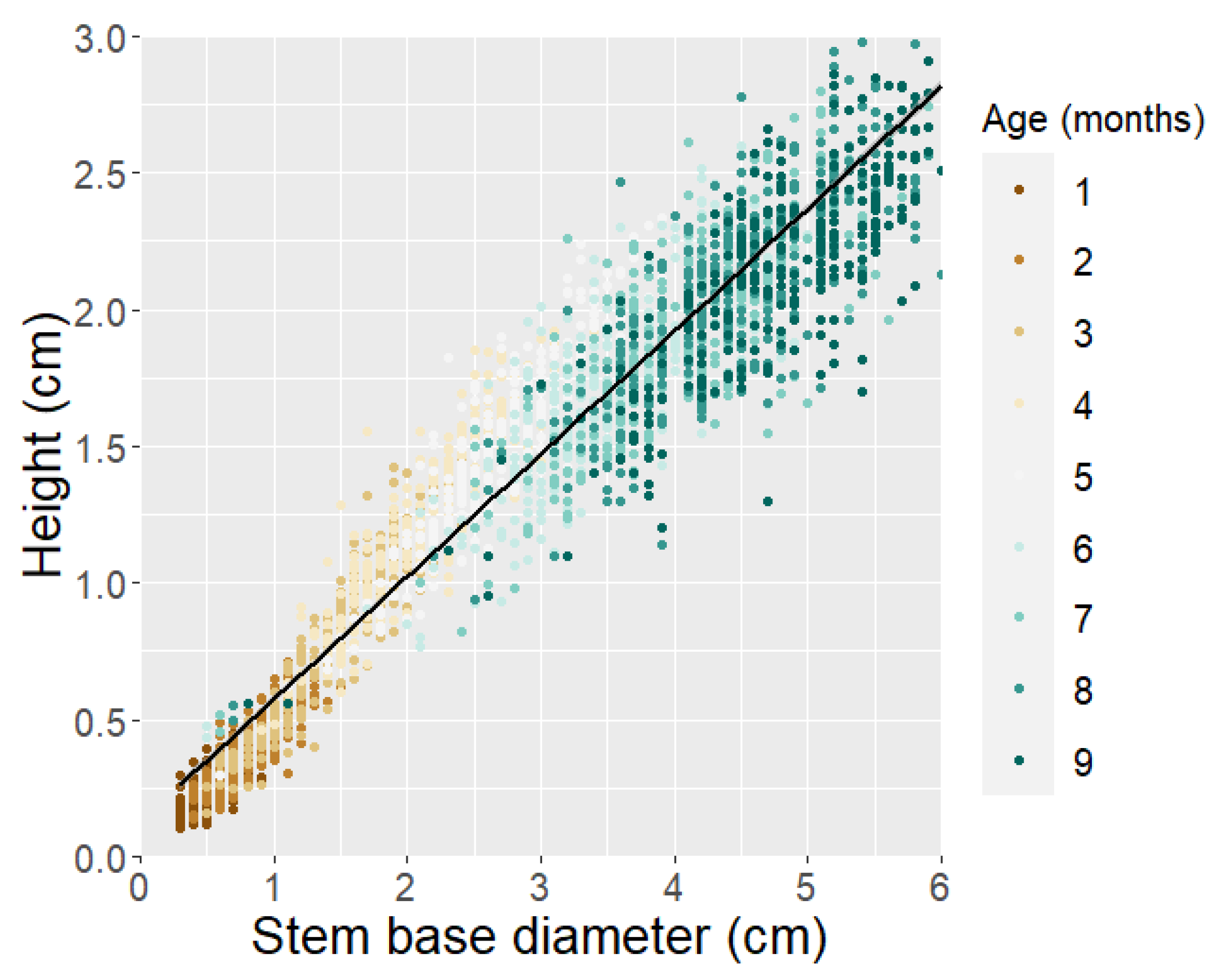
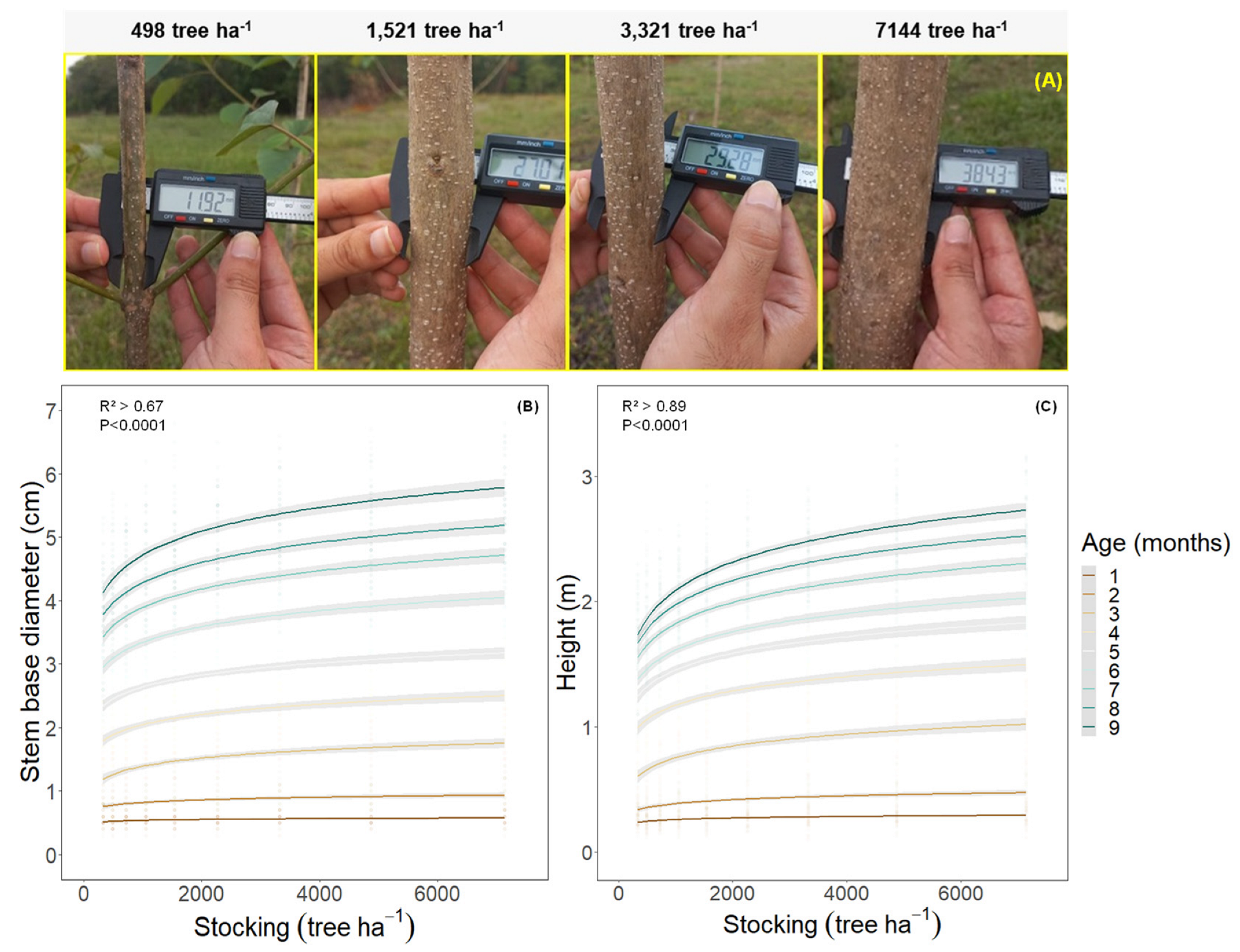
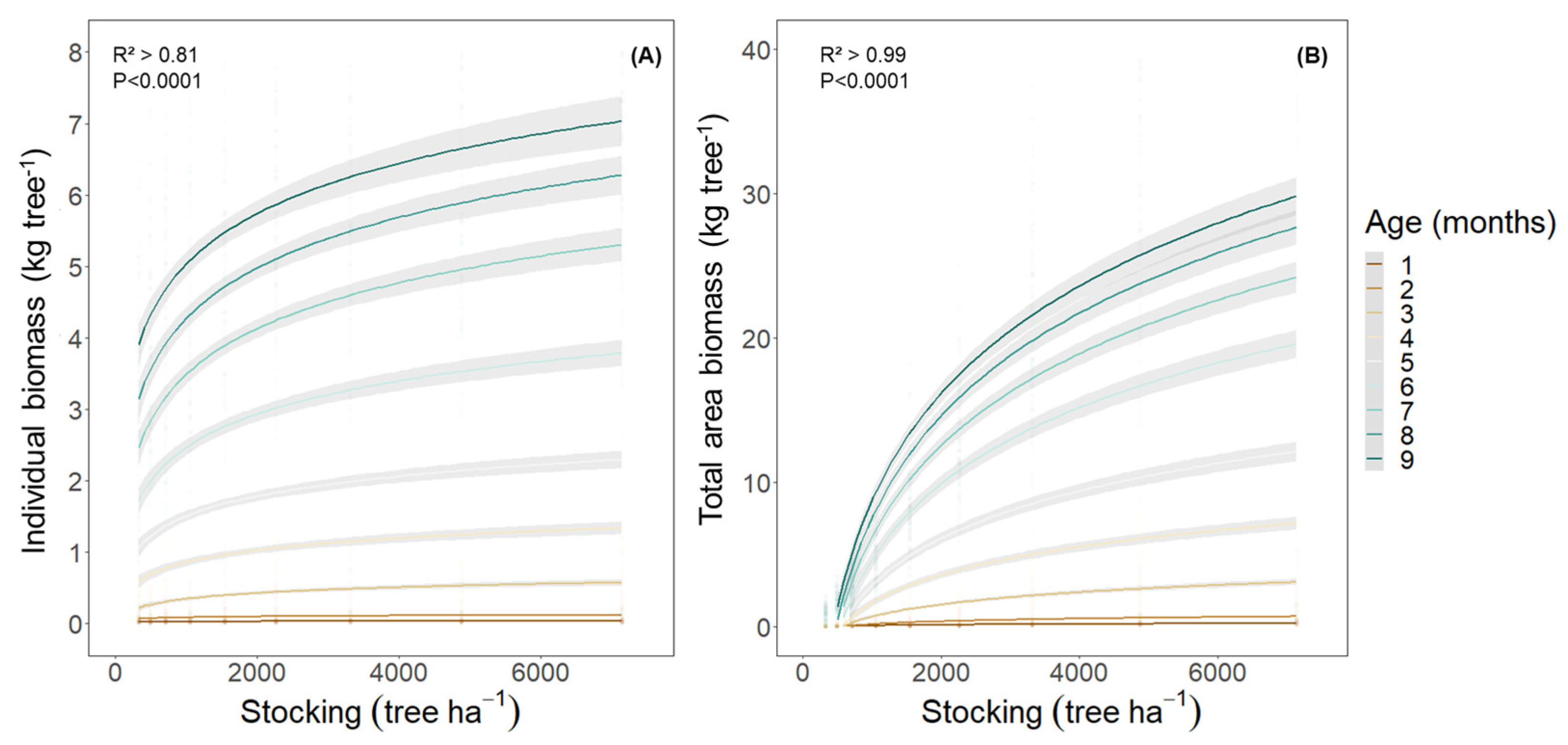

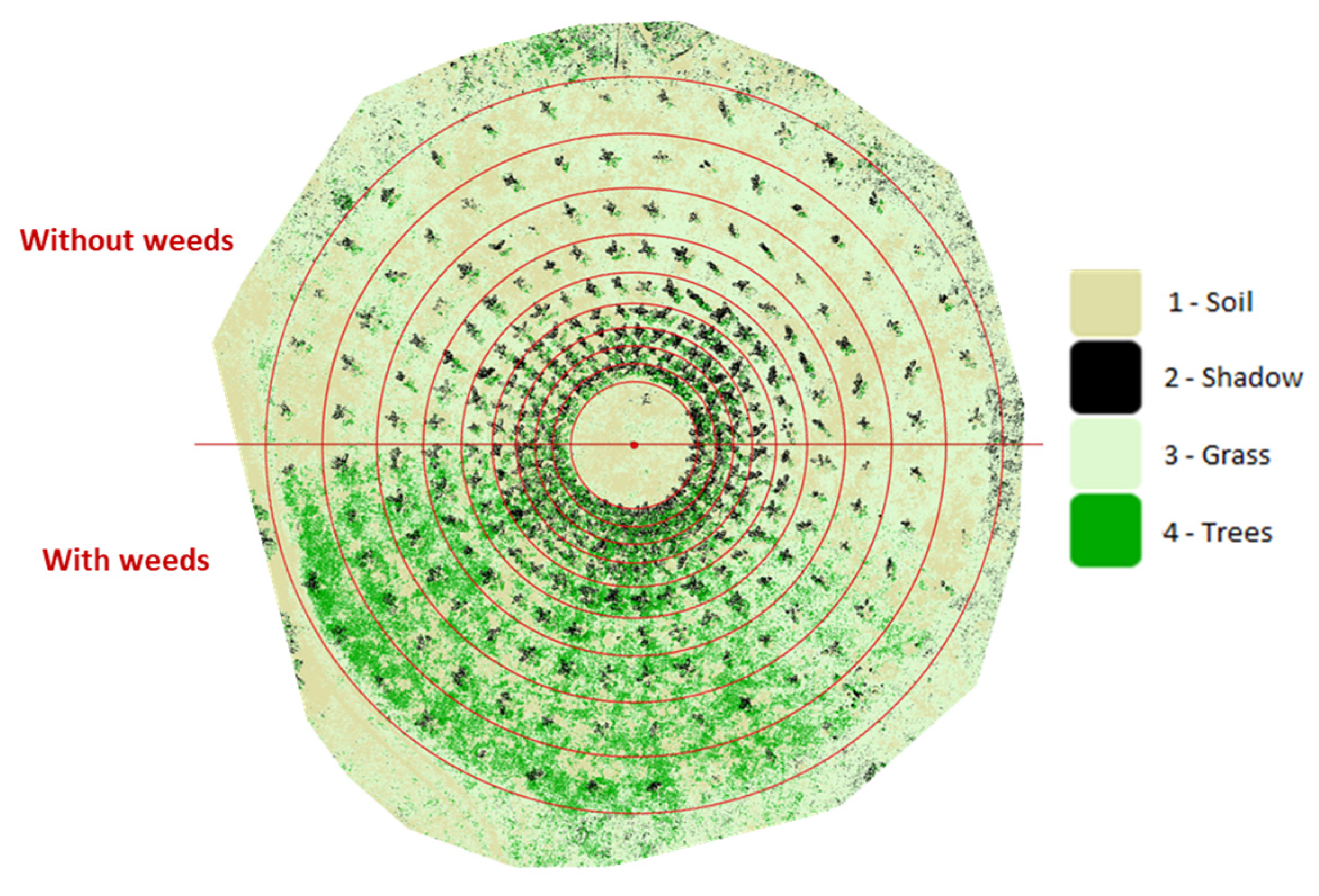
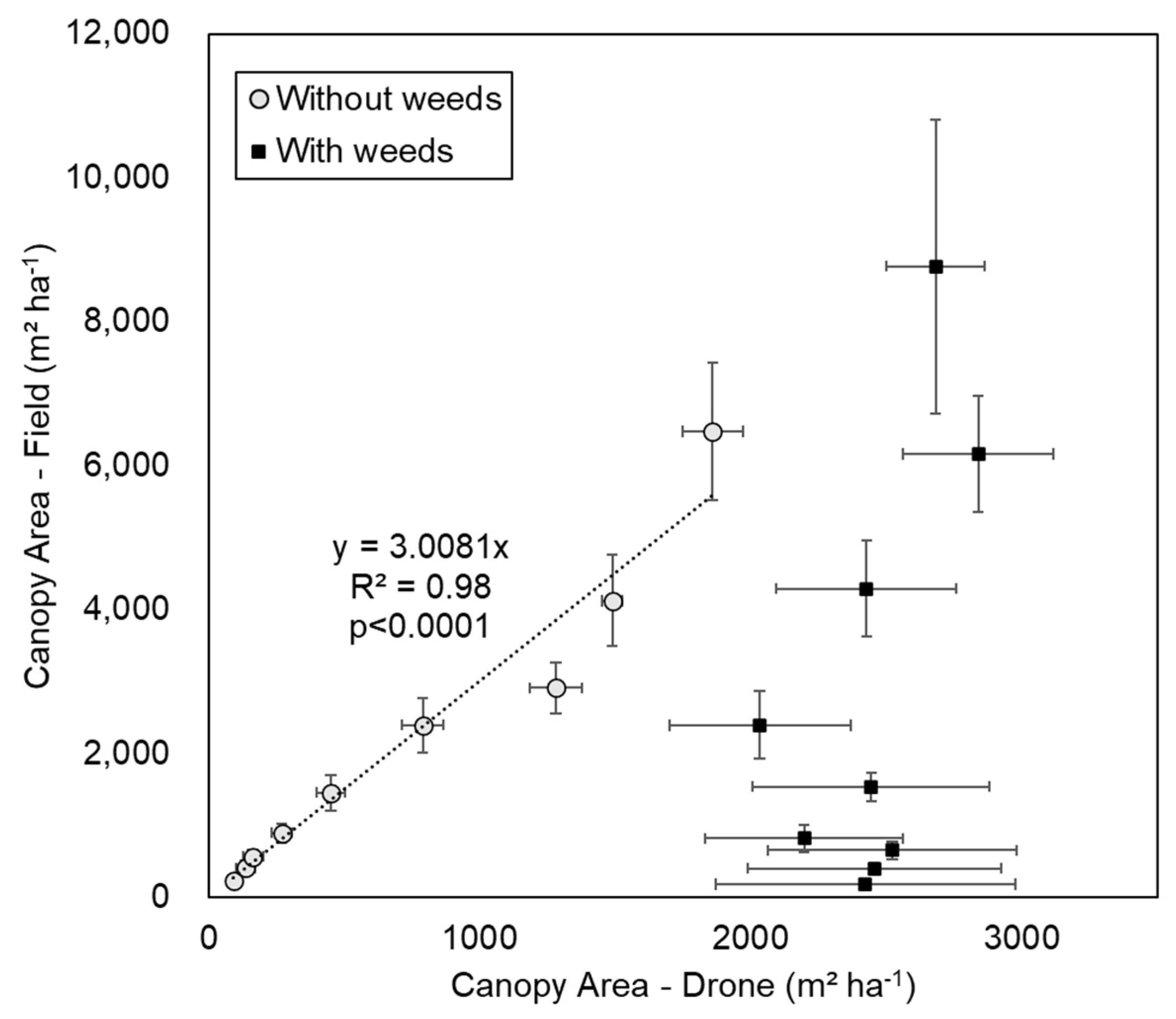
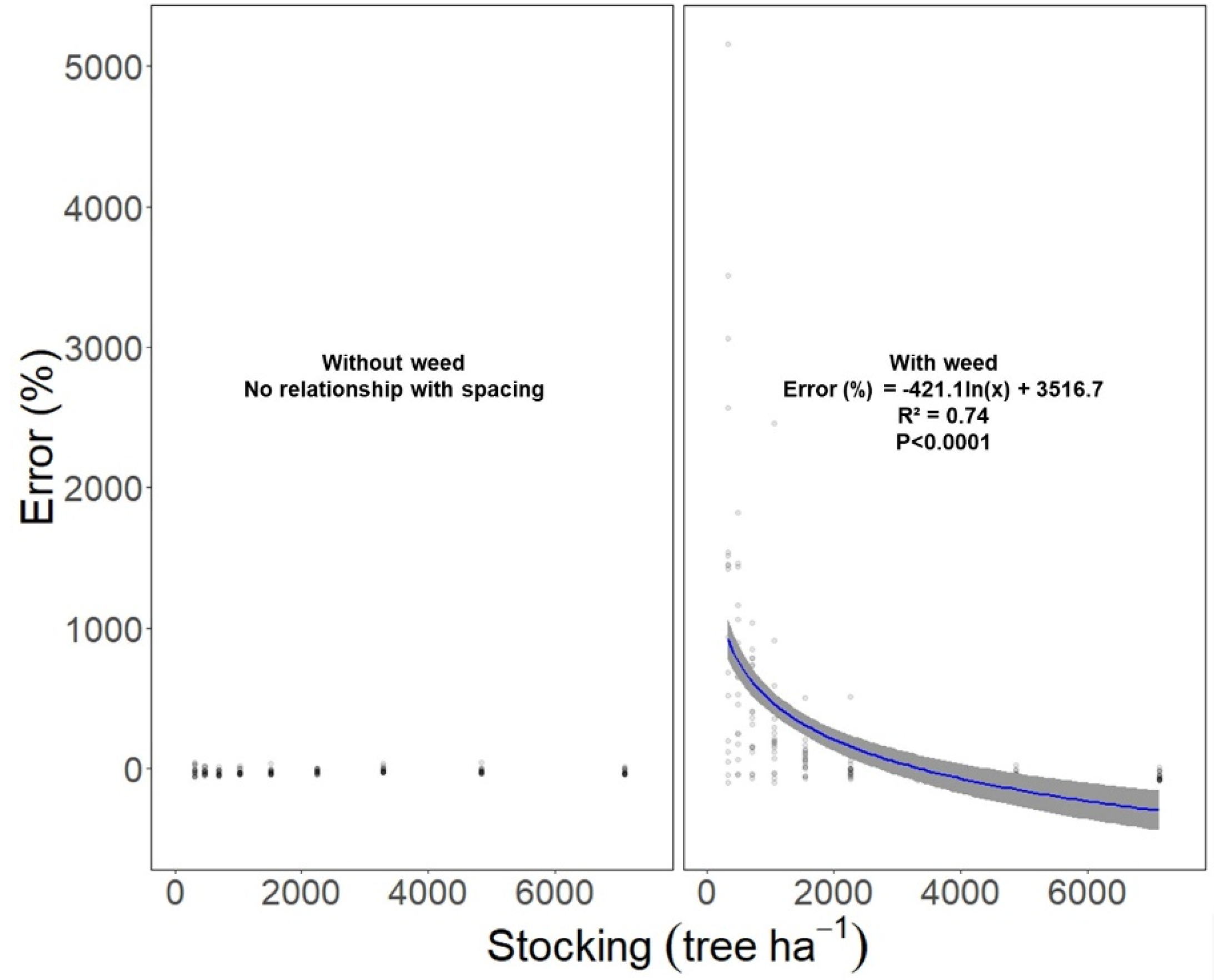
| Circle | Spacing (m2 tree−1) | Stocking (tree ha−1) |
|---|---|---|
| 1 | 6.4 | 7141 |
| 2 | 8.0 | 4877 |
| 3 | 9.5 | 3321 |
| 4 | 11.3 | 2265 |
| 5 | 13.7 | 1544 |
| 6 | 16.8 | 1052 |
| 7 | 20.4 | 716 |
| 8 | 25.0 | 489 |
| 9 | 30.0 | 300 |
Disclaimer/Publisher’s Note: The statements, opinions and data contained in all publications are solely those of the individual author(s) and contributor(s) and not of MDPI and/or the editor(s). MDPI and/or the editor(s) disclaim responsibility for any injury to people or property resulting from any ideas, methods, instructions or products referred to in the content. |
© 2023 by the authors. Licensee MDPI, Basel, Switzerland. This article is an open access article distributed under the terms and conditions of the Creative Commons Attribution (CC BY) license (https://creativecommons.org/licenses/by/4.0/).
Share and Cite
Hakamada, R.; Prados-Coronado, J.; Lages, C.; Vrechi, A.; Zuñiga-Grajeda, V.; Villota-Gonzalez, F.H.; Sulbaran-Rangel, B. Initial Growth of Gmelina arborea and Efficacy of RGB Image to Capture Canopy Area in a Large Range of Stockings. Remote Sens. 2023, 15, 4751. https://doi.org/10.3390/rs15194751
Hakamada R, Prados-Coronado J, Lages C, Vrechi A, Zuñiga-Grajeda V, Villota-Gonzalez FH, Sulbaran-Rangel B. Initial Growth of Gmelina arborea and Efficacy of RGB Image to Capture Canopy Area in a Large Range of Stockings. Remote Sensing. 2023; 15(19):4751. https://doi.org/10.3390/rs15194751
Chicago/Turabian StyleHakamada, Rodrigo, Jesus Prados-Coronado, Cassiano Lages, Arthur Vrechi, Virgilio Zuñiga-Grajeda, Freddy Hernan Villota-Gonzalez, and Belkis Sulbaran-Rangel. 2023. "Initial Growth of Gmelina arborea and Efficacy of RGB Image to Capture Canopy Area in a Large Range of Stockings" Remote Sensing 15, no. 19: 4751. https://doi.org/10.3390/rs15194751
APA StyleHakamada, R., Prados-Coronado, J., Lages, C., Vrechi, A., Zuñiga-Grajeda, V., Villota-Gonzalez, F. H., & Sulbaran-Rangel, B. (2023). Initial Growth of Gmelina arborea and Efficacy of RGB Image to Capture Canopy Area in a Large Range of Stockings. Remote Sensing, 15(19), 4751. https://doi.org/10.3390/rs15194751








